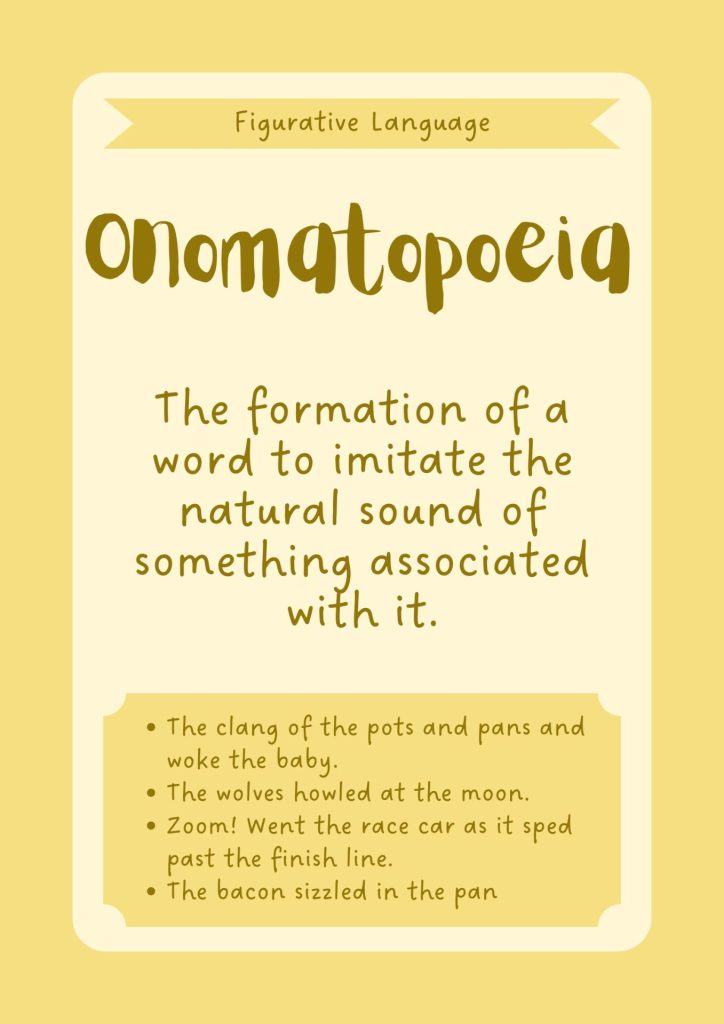What is Onomatopoeia? – Definition and examples
Table of Contents
Introduction
Onomatopoeia
Onomatopoeia is a fascinating literary device that adds a layer of sensory experience to writing by imitating natural sounds. Let’s delve into the world of Onomatopoeia and explore its significance in creating vivid and engaging literary works.
Analogy of Definition
What is Onomatopoeia?
Onomatopoeia is a figure of speech that mimics the natural sounds of objects and actions through words. It captures the auditory and visual essence of the sounds, allowing readers to experience the text on a sensory level.

Method
Identifying Onomatopoeia
Identifying Onomatopoeia in writing involves recognizing words that imitate sounds, such as ‘buzz’, ‘hiss’, ‘moo’, ‘crash’, ‘bang’, and ‘sizzle’. These words create aural and visual imagery, enhancing the reader’s experience.
When is Onomatopoeia Used?
One of the primary purposes of onomatopoeia is to evoke sensory experiences and create imagery that resonates with the reader. By incorporating words that mimic the sounds of real-life phenomena, writers can transport their audience to different environments and situations, enhancing the reader’s immersion in the text.
Onomatopoeic words are particularly effective in capturing the nuances of sound that may be difficult to convey through description alone. For example, instead of merely stating that a door slammed shut, using the onomatopoeic word ‘bang’ adds immediacy and impact to the action, allowing the reader to visualize and even hear the sound of the door closing.
Furthermore, onomatopoeia is often employed to create atmosphere and establish tone within a piece of writing. The choice of onomatopoeic words can convey a range of emotions, from the gentle rustling of leaves on a calm day (‘whisper’) to the chaotic cacophony of a bustling city street (‘buzzing’).
Types of Onomatopoeia
Onomatopoeia can be classified into several types based on the sounds they represent and how they mimic those sounds. Here are the main types of onomatopoeia:
Direct Onomatopoeia: Direct onomatopoeia involves words that directly imitate the sound they represent. These words closely resemble the actual sound they describe. For example, words like “buzz,” “hiss,” and “moo” imitate the sounds of bees, snakes, and cows, respectively.
Indirect Onomatopoeia: Indirect onomatopoeia involves words that do not directly imitate the sound they represent but still evoke a similar auditory experience. These words may capture the essence or quality of a sound rather than replicating it precisely. For example, the word “whisper” does not sound like the act of whispering itself, but it conveys the soft, hushed quality of the sound.
Coinage: Coinage involves the creation of new words specifically to mimic sounds. These words are often invented by writers or speakers to capture unique or unusual sounds that do not have existing onomatopoeic representations. For example, the word “kerplunk” was coined to represent the sound of a heavy object falling into water.
Phonomimes: Phonomimes are words that imitate the sound or tone of a particular language or dialect. These words may not represent specific sounds but instead convey the overall auditory impression of speech. For example, words like “jabber” and “mumble” mimic the rhythm and cadence of speech without reproducing actual words or phrases.
Echoic Words: Echoic words are onomatopoeic words that imitate sounds by repeating certain syllables or phonetic elements. These words create a sense of repetition or reverberation, similar to the original sound. For example, the word “crash” contains the repeated “sh” sound, which mimics the sharp, sudden impact of a collision.
Compound Onomatopoeia: Compound onomatopoeia involves combining multiple onomatopoeic words or elements to create a more complex representation of a sound. These words may incorporate various sounds and qualities to convey a specific auditory experience. For example, the word “clang-clang” combines the metallic ringing sound of “clang” with the repetition of “clang-clang” to evoke the noise of a bell ringing.
These types of onomatopoeia demonstrate the versatility and creativity of language in capturing and representing auditory experiences through words. They play a vital role in literature, poetry, and everyday communication, enriching language with vibrant and evocative descriptions of sounds and sensations.
Examples
Example 1: The bees buzzed around the garden.
Example 2: The kettle sizzled as it boiled.
Example 3: The thunder crashed loudly in the distance.
These examples illustrate the use of Onomatopoeia in creating auditory and visual imagery within the text. By imitating natural sounds, Onomatopoeia enhances the reader’s experience and adds depth to the writing.
Quiz
Tips and Tricks
1. Poetry and Onomatopoeia
Tip: Incorporate Onomatopoeic words in poetry to evoke sensory experiences and create vivid imagery.
2. Prose and Onomatopoeia
Tip: Use Onomatopoeia in prose to bring scenes to life and engage the reader’s senses.
3. Comics and Onomatopoeia
Tip: Employ Onomatopoeic words in comics to visually represent sounds and actions, enhancing the reader’s visual experience.
4. Children’s Literature and Onomatopoeia
Tip: Introduce Onomatopoeia in children’s literature to captivate young readers and stimulate their imagination.
5. Creating Atmosphere with Onomatopoeia
Tip: Use Onomatopoeia to set the tone and mood of a piece of writing, creating a sense of atmosphere and emotion.
Real life application
Story: The Onomatopoeic Adventure of Lily and Max
Lily and Max embarked on an imaginative adventure filled with Onomatopoeic wonders that brought their surroundings to life.
Adventure 1: The Enchanted Forest
As Lily and Max ventured into the enchanted forest, they heard the rustling of leaves and the chirping of birds, immersing them in the magical world of Onomatopoeia.
Adventure 2: The Pirate’s Cove
Exploring the pirate’s cove, Lily and Max encountered the crashing of waves and the creaking of old wooden ships, experiencing the power of Onomatopoeia in creating a sense of adventure and excitement.
Adventure 3: The Haunted Castle
In the haunted castle, Lily and Max were surrounded by eerie whispers and ghostly moans, showcasing the evocative nature of Onomatopoeia in setting the mood and atmosphere.
FAQ's
Like? Share it with your friends

